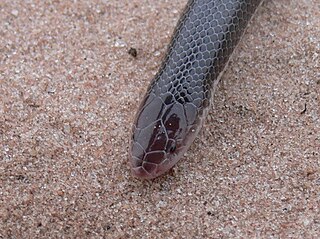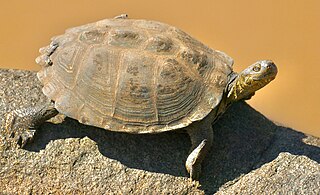
Ptenopus is a small genus of lizards, known commonly as barking geckos, in the family Gekkonidae. The genus is endemic to southern Africa. There are only three described species in this genus.

Dasypeltis is a genus of colubrid snakes. It is one of only two taxonomic groups of snakes known to have adapted to feed exclusively on eggs. Dasypeltis are non-venomous and found throughout the continent of Africa, primarily in forested or wooded habitats that are also home to numerous species of birds.

Atractaspis bibronii is a species of venomous snake in the family Atractaspididae. The species is endemic to Africa. There are no subspecies that are recognised as being valid. Its common names are the Southern stiletto snake, Bibron's stiletto snake, Side-stabbing snake; previously it was known as Bibron's burrowing asp, Bibron's mole viper, and the mole adder.

Dasypeltis scabra, known as the common egg eater, egg-eating snake or rhombic egg eater, is a species of snake in the family Colubridae. It is endemic to Africa.

Storeria dekayi, commonly known as De Kay's brown snake, De Kay's snake, and simply the brown snake, is a small non-venomous species of snake in the family Colubridae. The species is native to North America and Central America.

The berg adder is a venomous viper species endemic to mountainous regions in southern Africa. No subspecies are currently recognized.

The rinkhals, also known as the ringhals or ring-necked spitting cobra, is a species of venomous snake in the family Elapidae. The species is found in parts of southern Africa. It is not a true cobra in that it does not belong to the genus Naja, but instead belongs to the monotypic genus Hemachatus. While rinkhals bear a great resemblance to true cobras they also possess some remarkable differences from these, resulting in their placement outside the genus Naja. In 2023, the Zimbabwe population was described as a new species, H. nyangensis.

Aparallactus is a genus of rear-fanged mildly venomous snakes found in Africa. Currently, 11 species are recognized.

Lycophidion is a genus of nonvenomous lamprophiid snakes commonly referred to as the wolf snakes.

The Cape wolf snake is a species of oviparous, nonvenomous snake which occurs over a wide area of Southern, Central, and East Africa. Though docile and harmless, it may be confused with the very venomous stiletto snake.

The rufous beaked snake is a species of mildly venomous snake in the family Psammophiidae. The species is native to East Africa. Its common name refers to its hooked snout, which it uses to dig burrows, and to its reddish-brown dorsal coloration. It hunts small animals during the day with the help of its venomous bite.

The flap-necked chameleon is a species of arboreal chameleon, a lizard in the family Chamaeleonidae. The species is native to sub-Saharan Africa. There are eight recognized subspecies, including the nominotypical subspecies.

Aparallactus guentheri, or the black centipede-eater, is a species of mildly venomous rear-fanged snake in the family Atractaspididae. The species is endemic to Africa.

The serrated hinged terrapin is a species of turtle in the family Pelomedusidae. The species is native to East Africa and Southern Africa. There are two recognised subspecies.

Anchieta's cobra, sometimes referred to as the Angolan cobra, is a species of venomous snake in the family Elapidae. The species is native to Southern Africa.

Chirindia is a genus of amphisbaenians in the family Amphisbaenidae. Commonly known as pink round-headed worm lizards, species in the genus Chirindia are native to East Africa and southern Africa, from Tanzania to South Africa. They are unpigmented worm lizards with rounded heads, and extensive fusion of the head shields.

Lycodonomorphus inornatus, commonly known as the olive house snake, the black house snake, and the olive ground snake, is a species of nonvenomous snake in the family Lamprophiidae. The species is endemic to southern Africa. It is a nocturnal snake with terrestrial habits.

Elapsoidea sundevallii, also known commonly as Sundevall's garter snake or African garter snake, is a species of venomous snake in the family Elapidae. The species is native to Southern Africa. There are five recognised subspecies.




















